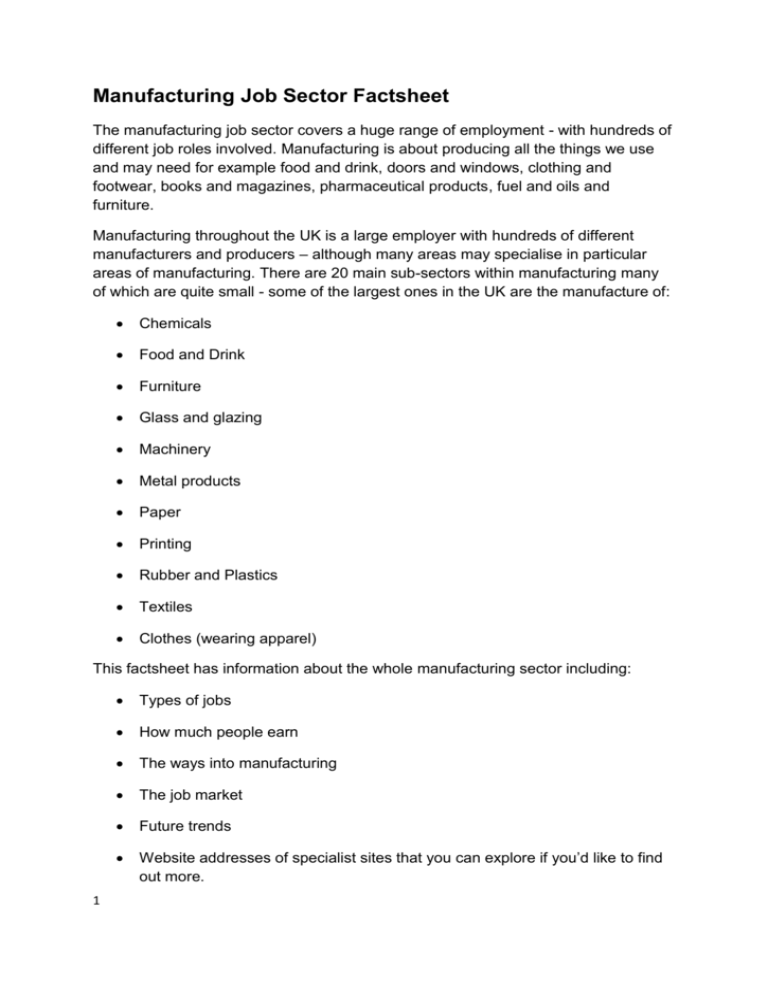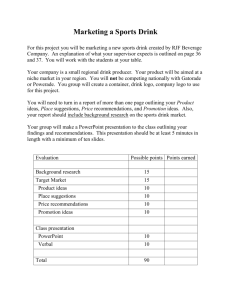Manufacturing - World of Work
advertisement

Manufacturing Job Sector Factsheet The manufacturing job sector covers a huge range of employment - with hundreds of different job roles involved. Manufacturing is about producing all the things we use and may need for example food and drink, doors and windows, clothing and footwear, books and magazines, pharmaceutical products, fuel and oils and furniture. Manufacturing throughout the UK is a large employer with hundreds of different manufacturers and producers – although many areas may specialise in particular areas of manufacturing. There are 20 main sub-sectors within manufacturing many of which are quite small - some of the largest ones in the UK are the manufacture of: Chemicals Food and Drink Furniture Glass and glazing Machinery Metal products Paper Printing Rubber and Plastics Textiles Clothes (wearing apparel) This factsheet has information about the whole manufacturing sector including: 1 Types of jobs How much people earn The ways into manufacturing The job market Future trends Website addresses of specialist sites that you can explore if you’d like to find out more. Some of the other main areas such as machinery manufacture, automotive and aeronautical, chemical, electrical and electronic and medical equipment are included in the engineering sector as these are areas with a strong element of design and engineering as well as manufacture. The manufacturing sector also employs professional engineers, designers, and scientists, and details of these jobs are included in the engineering and the science job families. 2 Types of Jobs Jobs – and many job titles - across the manufacturing sector vary according to the sector they are in. However manufacturing jobs are mainly offered at four different levels with different entry level qualifications including: Trainee/apprenticeship such as trainee pre-press operative (printing), apprentice baker (food and drink), trainee packing operative, trainee print estimator, trainee production operative, trainee installer/glazier, apprentice maintenance engineer, apprentice laboratory assistant, or apprentice cabinet making (furniture). Operative – such as food and drink process operative (food and drink), chemical plant process worker, metals industry production operative, motor vehicle manufacturing operative, plastics process operative, sheet metal worker, textile operative, foundry process operator, assembler, production operative, distribution operative, pre-press operator (print), furniture assembly, or packing and dispatch operative. Skilled and Technician – such as food scientist/technologist, quality assurance technician, food safety adviser, laboratory technician, polymer technician, optical engineering technician CAD designer, graphic designer, furniture designer, wood machinist or specialist skilled crafts such as cabinet maker, baker, cake decorator, book binder, brewer or butcher. Management – such as general plant manager, process team leader, estimator, production manager, operations manager, sales manager, purchasing manager, new product development , packaging manager, human resources manager, accounts manager, quality control inspector/manager, senior product design engineer , senior graphic designer, senior furniture designer, senior maintenance engineer, product technologist, food safety adviser, consumer analyst and health and safety officer. Want to know more? The list in this jobs section is a selection of job titles in manufacturing to give a snapshot of this sector. To find out more about ways into these different levels of jobs see pages 5 - 6 You can also use the Next Step website https://nextstep.direct.gov.uk/ to find out about 100s of jobs and careers, including the ones listed above and many, many more. 3 Pay Apprenticeships There is no set rate of pay for apprentices in any industry including manufacturing, however all employed apprentices must receive a wage of no less than £2.50 per hour and a recent survey (November 2010) showed that the average wage per week for an apprentice is now around £170 and in some job roles around £210 per week. It may go up as your skills increase. As an apprentice, you will receive the same benefits as other employees such as pension contributions, subsidised canteen and leisure facilities. Operative level Operatives earn a range of pay – depending on the manufacturing sector – these range from £10,000 and up to as high as £20,000 a year. Average pay for operatives with some experience is around £14,000 a year. Skilled and Technician Technicians and skilled workers earn a range of pay – depending on the manufacturing sector and the shortage of people with a specific skill – these range from £18,000 and up to as high as £45,000 a year. Management Managers earn a range of pay – depending on the manufacturing sector – these range from £22,000 and up to as high as £75,000 a year (or more in a few senior management roles in some manufacturing sectors). Salary figures from jobs4U website - www.connexions-direct.com/jobs4u 4 Ways in to manufacturing There are four main entry points into manufacturing. The qualifications you need for entry depend on the level you start at. It is possible to improve both your skills and your prospects by taking additional training and qualifications, to enable you to progress from operative to technician/skilled level and on to management level. Main entry points: Apprenticeship level There are apprenticeships on offer right across the manufacturing sector so you can train up to operative or technician level via an apprenticeship. Apprenticeship vacancies can be searched on www.apprenticeships.org.uk Operative level Although it is possible to find a job as a manufacturing operative without any formal qualifications, GCSEs (A*-E) can be useful, especially if you are keen to start training on an Apprenticeship. With increased automation and use of technology, operatives need to have some understanding of Information Technology and of the systems involved in producing goods. Some employers may ask applicants to take a technical aptitude test to assess their manual skills. Many operatives start as apprentices and train on the job. There are also preemployment training courses at some colleges and training providers, and a range of manufacturing-related qualifications at different levels, including Foundation or Higher level Diplomas in Manufacturing and City & Guilds qualifications. The main route into craft level is through an Apprenticeship. There are no set qualifications required for entry, but individual employers may ask for at least four GCSEs (A*-C), including English, maths and a subject such as science, engineering, or design and technology or the Diploma in engineering or construction and the built environment at higher level. Technician/ skilled level Technicians and skilled manufacturing workers can either train with an employer on an Apprenticeship, or take a full-time or part-time college course and then apply to an employer for a trainee technician post. Individual employers may ask for at least four GCSEs (A*-C), including English, maths and a subject such as science, engineering, or design and technology or the Diploma in manufacturing or engineering at higher level. 5 It may be possible to start as a trainee technician with four GCSE's (A*-C) via an Apprenticeship scheme. The Diploma in manufacturing or the Diploma in engineering may also be relevant. Some skilled jobs such as graphic design, furniture design or food technologist may require specific qualifications and/or experience in the skill area. Management level It may be possible to start as a trainee manager with four GCSE's (A*-C) via an Advanced Apprenticeship scheme. Employers may ask for at least four GCSEs (A*C), including English, maths and a subject such as science, engineering, or design and technology or the Diploma in manufacturing or engineering at higher level. Some manufacturing managers enter after an industry related degree - for example in manufacturing or management or a specific skill area such as product design, digital product design, accountancy, food science/technology or materials science. Minimum qualifications for manufacturing degrees are generally a minimum of two A levels or equivalent and five subjects at GCSE (A*-C) or equivalent. Some degree subjects such as product design and food science may have specific subject requirements at A level or equivalent so do check the subject that interests you on www.ucas.co.uk. There are also a range of manufacturing foundation degrees – these generally require a minimum of one A level or equivalent and four subjects at GCSE (A* - C) or equivalent. Some manufacturing degrees combine a foundation year as a starting point to an honours degree. For more information about the courses on offer locally for 14-19 year olds including the new Diplomas - why not check out your local area prospectus? Barnsley - www.barnsley1419.info For courses in higher education check out the UCAS website - www.ucas.com For Apprenticeships check out vacancies on this site: National Apprenticeship site - www.apprenticeships.org.uk You can also ring the Barnsley Connexions Centre for information on local Apprenticeships: 01226 205686. 6 The Job Market The UK is the world’s sixth largest manufacturer. Manufacturing generated £150 billion for the UK economy in 2008. It accounted for 55% of all exports and 75% of industrial research and development (£22.5 billion). Manufacturing and production employs around 2.25 million people in England – around 10% of the working population. Manufacturing areas related to engineering are covered in the job market pages about engineering for example aeronautical engineering and medical engineering so to find out about the whole sector in detail read the engineering job sector too. The information in this section is about the: Process and manufacturing sector – covered by the Proskills Sector Skills Council Food and drink manufacture –covered by the Improve Sector Skills Council The process and manufacturing sector includes: Building Products Coatings Extractive and Mineral Process Furniture, furnishings and interiors Glass and related industries Glazed ceramics Paper Print Wood For food and drink see section on page nn These areas above employ 810,000 employees and there are 79,600 workplaces. 7 The majority of employers - 80% - employ less than 10 employees. However - although only 1% of companies have more than 200 employees, this is about a quarter of the total workforce. There are a large number of multinational organisations, but none employ more than 10,000 in the UK. Although there overall size of the sector workforce is forecast to decrease over the next ten years, there will still be a need for almost 93,000 extra people up to 2017. Over the same period, there is a forecast fall in the number of lower level occupations, but a rise in demand for higher level skills. The building products (42%), glass (38%) and extractive and mineral processing (36%) industries were the most likely to have experienced a decrease in their workforce. One in five coatings firms (20%) has experienced an increase in the size of their workforce. The workforce is also more likely than average to have grown in the glass sub-sector (16%). Larger companies are more likely to have suffered decreases in their workforces than smaller companies. 9% of manufacturing employers in England reported recent workforce growth in 2009. The largest industries in this sector are: printing which employs 206,000 people in 27,000 workplaces glass which employs 168,000 people in 21,600 workplaces furniture manufacturing which employs 149,000 people in 12,200 workplaces Paper manufacturing which employs 99,000 people in 3,600 workplaces Extractive and mineral processing which employs 86,000 people in 10,000 workplaces Building products which employs 51,000 in 3,000 workplaces Recent technological changes are having a big impact on manufacturing with a shift towards E-manufacturing. E-manufacturing is about using information and communication technologies and electronics not just in the factory but throughout the supply chain. For example 3D printing - as it becomes more sophisticated, smaller and cheaper to purchase - is now able to produce physical objects so that modelling and some products can be produced away from a factory. (See also future trends section.) Sources: Proskills Sector Skills Assessment 2010 and The 2009 Employer Survey 8 Food and Drink Food and Drink The main areas covered by food and drink are: Animal feed Bakery Beer Confectionery Dairy Fish Meat Soft Drinks The food and drink manufacturing and processing industry in the UK is the largest manufacturing sector. 9 There are about 460,000 people employed in the UK Food and Drink Manufacturing industry – that’s 15% of the total manufacturing workforce. They are employed in more than 11,100 workplaces and in addition 15,800 retail baker, butcher and fishmongers. The largest employers in food and drink manufacturing are Bakery and meat manufacturing and processing employers. Although manufacturing of food and drink takes place throughout the UK the areas with the largest percent of employees are Yorkshire and Humberside (14% of all employees), the North West, Scotland and East Midlands. The West Midlands (10%) and the South West (11%) also have significant numbers in employment. The majority of workers in the sector are described as ‘process, plant, and machine operatives’ (34%) and ‘elementary positions’ (15%). A further 15% are employed as ‘managers and senior officials’. Skilled trades include occupations such as butcher, baker, brewer, fish filleter and cake decorator. 67% of the workforce is male. 23% of female workers are employed part-time as compared to 4% of male workers. 90% of the workforce is employed full-time. 96% of people working in the sector are employees Most of the workforce – 65% - is employed in companies with 1-10 employees and only 5% are employed in companies with more than 200 employees. 26% of the workforce is aged 16-30 years; 36% are aged 45 years and over Over a third of the current workforce will retire in the next 20 years. Recently, there have been major changes in consumer behaviour which impact on the sector, such as: o the traditional ‘three meals a day’ is being replaced by snacking and grazing o the increasing number of households and decreasing household size leads to a greater demand for smaller pack sizes o a greater reliance on ‘others’ to prepare and cook food which has resulted in a greater demand for ready prepared food o an increasing awareness of regional and local food and the impact on the environment caused by importing food – especially fresh food products. o a greater awareness by consumers of food production systems and a lack of confidence in mainstream food Source: Improve AACS LMI report 2010 and UK Labour Market Information Profile 2009/2010 10 Local trends Yorkshire and Humberside The process and manufacturing sector More than 97,000 people work in the process and manufacturing sector in Yorkshire and the Humber. The largest work areas in Yorkshire and the Humber in manufacturing include: o Glass and glazing which has 30,600 employees working in 2,270 workplaces o Furniture manufacture which has 23,400 employees working in 1,240 workplaces o Printing which has 20,400 employees working in 2,080 workplaces o Paper which has 13,400 employees working in 310 workplaces o Extractive and mineral processing which has 7,100 employees working in 970 workplaces The majority of firms - 73% - in the Yorkshire and Humber manufacturing industry have fewer than 10 employees, but even though only 2% of companies have more than 200 employees, a third of the total workforce work in these larger companies. 75% of the workforce is male, although the proportion of women in the sector is rising year on year. Around 23% of employees in the Yorkshire and Humber manufacturing sector fall into the process, plant and machine operatives occupational category, and slightly more are classed as skilled trades (26%). Recent forecasts suggest that employment in manual and semi-skilled roles will continue to decrease as this shift progresses, but also that there will be a simultaneous rise in higher level managerial and technical roles. Sources: Proskills Sector Skills Assessment – England 2010, annex H. Data derived from the Annual Business Inquiry 2007 and the Labour Force Survey 2008. The Yorkshire and the Humber sector profile, 2007/08 11 Food and drink The food and drink manufacturing industry in Yorkshire and the Humber employs an estimated 52,700 people – this is 12% of the food and drink manufacturing sector’s workforce in England. There are 1,300 workplaces in and the majority are small employers with 64% of staff working in organisations of between 1 and 10 staff, and only 6% working in organisations of over 200 staff. Meat and bakery manufacturing employers are the main employers making up almost half of all the food and drink manufacturing in Yorkshire and the Humber area The Yorkshire and Humber food and drink sector makes up 17% of the region’s total manufacturing workforce. 90% of the workforce is employed full-time. 24% of all female workers are employed part-time, compared with 4% of all male workers. The majority of employees are aged 20-24 years (16%) and 40-44 years (16%). Over a third of the current workforce will retire in the next 20 years. 66% of employees are employed at operative or elementary level, 18% at skilled and technical level and 16% at professional and management level. Source: Yorkshire and the Humber Labour Market Information Profile 2009/2010 12 Future Trends Since 1998, there has been a steady decline in the numbers employed in the sector as a whole and the number of workplaces, but productivity in the sector has continued to increase over the same period. January 2011 figures released by the Office of National Statistics (ONS) show total manufacturing output increased by 5.6% in November 2010 compared with November 2009. This was the highest growth rate for 16 years. Output increased in most manufacturing areas – large growth areas include an increase of: 20% in the machinery and equipment manufacturing industries 11.6% in the basic metals and metal products sector 8.7% in the food and drink industries The only decline was in chemicals and manmade fibres with a decrease of 2.8% The Engineering Employers Federation (EEF) predicts that manufacturing will continue to grow in 2011 at an average 3.5% By 2017, 587,000 new workers will need to be recruited into the manufacturing sector. However the profile of workers is predicted to change. Overall, almost 47% of all employees in 2017 will be at associate professional level or higher, compared with just over 32% in 1987. Growth in 2011 has been based on solid growth in orders for exports – particularly to emerging markets based on a weaker pound which is boosting demand from overseas. This may affect growth if the pound becomes stronger. There are significant changes taking place in manufacturing which is driving the need for workers at higher rather than lower levels as IT and electronics increases productivity and efficiency. Modern working practices and advances in technology in the sector will mean that businesses will become more automated over the coming years. Operatives increasingly need to be able to multi-task so they may not only be on the production line but also be dealing with quality control checking and/or machinery maintenance. New inventions and also older technologies become more affordable also will continue to impact on the market. For example 3D printing - a way of fabricating objects designed on the computer - has become more affordable and advanced 13 recently and is set to make manufacturing more possible on a smaller scale and news reports have recently predicted manufacturing taking place in the home! One scheme that is looking to use this technology is RepRap – short for Replicating Rapid Prototyping – which offers a cheap way of replicating objects including the printer itself. The 3D printer – currently the size of a microwave - can print out parts that can then be assembled. The ability to produce specially designed objects from a computer will make it possible to manufacture on a smaller scale. These printers work with a whole range of different materials including plastics and certain types of metals. The US army have experimented using rapid prototyping to create parts for broken tanks, guns and other hardware in combat situations. Source: Proskills AACS LMI Report 2010 and Proskills Sector Skills Assessment 2010 Food and drink Manufacturing Job losses are expected to be concentrated within low and mid-skill level occupations, including Skilled Trades and Operative roles. Expanding numbers of high-skill level occupations are predicted, including Managers and Senior Officials and Professionals. 44,000 high-skill level jobs are forecast to be needed between 2007-2017 and 54,000 low-skill level jobs. Across the sector as a whole, recruitment issues are primarily in technical and skilled jobs, such as engineering, food scientists and technologists, quality assurance, bakers, millers, fish-filleters and smokehouse operators. New and emerging occupations include: 14 Operational Level Jobs – Production control operations increasingly include machinery maintenance activities. Operation roles increasingly include quality monitoring and reporting tasks. First Line Management – Team leadership roles are now replacing supervisor roles within flat management structures. Environmental Control and Sustainability Roles – These roles are now being developed at junior/middle management level. Productivity and Improvements Roles – These are increasingly becoming important at junior/middle management levels. Corporate, Social Responsibility Roles – Senior management level roles are increasingly linked to environmental and sustainability agendas. Sources: Improve AACS LMI report 2010 Projection figures from ’Working Futures 2007 -2017’ Warwick Institute of Employment Research - November 2008. 15 Find out more about Manufacturing www.automotive-skills.org.uk Sector Skills Council for the automotive industry. www.bfm.org.uk British Furniture Manufacturers' Association (BFM) www.britglass.org.uk British Glass www.bpf.co.uk British Plastics Federation www.brppa.co.uk The British Rubber and Polyurethane Products Association www.cogent-ssc.com Sector skills Council for the oil and gas, chemicals, nuclear, petroleum and polymer industries. www.instituteofcarpenters.com The Institute of Carpenters (IOC) www.connexions-direct.com/jobs4u You can use this site to find out about all the jobs in this sector in more detail. www.careersbox.co.uk A free national careers film library showing films of people doing jobs. www.direct.gov.uk/diploma The official government site about all the different diplomas www.enginuity.org.uk Enginuity the site that’s all about engineering and technology careers. www.materials-careers.org.uk Institute of Materials, Minerals and Mining’s careers site 16 www.imeche.org Institution of Mechanical Engineers (IMechE). www.iomnet.org.uk Institute of Operations Management (IOM) www.manufacturinginstitute.co.uk The Manufacturing Institute www.proskills.co.uk and www.prospect4u.co.uk Proskills UK Sector Skills Council for manufacturing and process industries www.semta.org.uk SEMTA - The Sector Skills Council for Science, Engineering and Manufacturing Technology and the lead for the Diploma in Engineering. www.scenta.co.uk SCENTA Limited - careers information in science, engineering and technology. www.sectorcareersinfo.co.uk This site has a link to all sector skills councils. www.materials.ac.uk UK Centre for Materials Education www.metskill.co.uk Metskill (Metal Industry Skills and Performance). www.wisecampaign.org.uk Women into science, engineering and construction – careers information for girls. www.youngeng.org Young engineers to encourage young engineers. Food and Drink www.improve-skills.co.uk Improve SSC - the site also has and interactive online careers service on the website available www.improve-skills.co.uk/careers/careers-information/dunkan 17 www.foodanddrink.nsacademy.co.uk National Skills academy for Food and Drink Manufacturing www.careersinfoodanddrink.co.uk/ Careers in Food and Drink www.fdf.org.uk Food and Drink Federation Factsheet produced by Prospects January 2011 18








